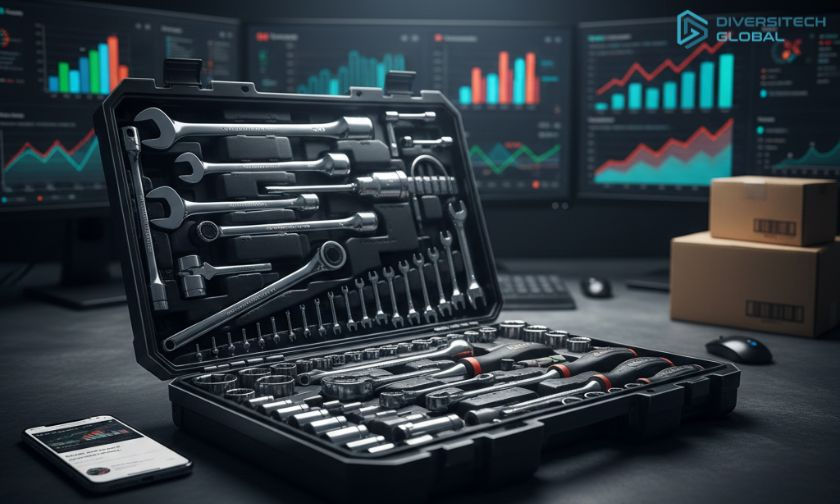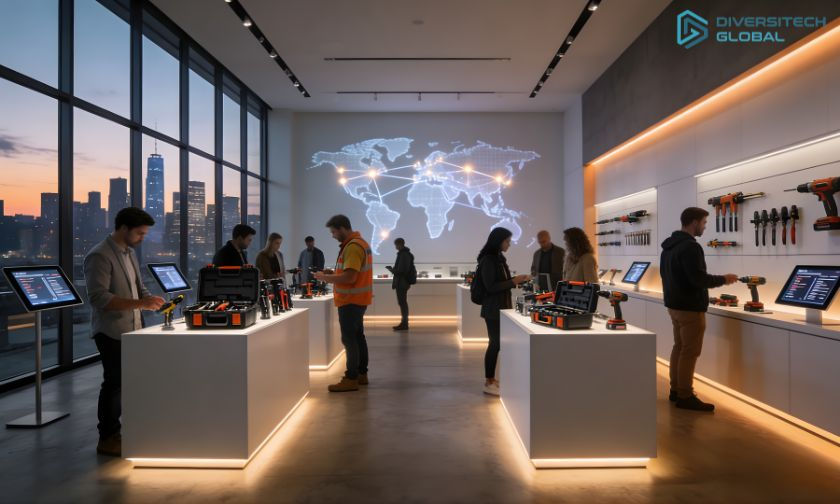Revolutionary Innovations in Tool Design and Engineering
- Diversitech Global

- Feb 8, 2024
- 6 min read
Updated: Feb 21, 2024

Welcome to our detailed exploration of revolutionary innovations in tool design and engineering. As a leading DIY tools company, Diversitech Manufacturing is dedicated to staying at the forefront of advancements in the industry.
In this article, we will delve into the cutting-edge innovations that are revolutionizing the world of DIY tool design and engineering. From ergonomic design and advanced materials to precision engineering and user-centric features, each section will provide valuable insights into the latest trends and breakthroughs. Whether you're a professional contractor or a DIY enthusiast, this guide will keep you informed about the exciting developments in the tools and hardware market.
Table of Contents:
Ergonomic Design for Enhanced User Experience
Ergonomic design has become a key focus in tool design and engineering, with manufacturers prioritizing user comfort and efficiency. Tools that are ergonomically designed minimize user fatigue, reduce the risk of injuries, and enhance overall productivity. Consider the following examples:
Comfortable Grips: Tools with soft and contoured handles provide a secure grip and reduce hand strain during prolonged use.
Weight Distribution: Well-balanced tools with optimized weight distribution ensure ease of handling and reduce the strain on the user's wrists and arms.
Adjustable Features: Tools with adjustable components, such as handles and cutting depths, allow users to customize the tool to their specific needs and preferences.
By incorporating ergonomic design principles, manufacturers are creating tools that are not only efficient but also comfortable to use, enabling users to work for extended periods without discomfort.
Advanced Materials for Durability and Performance
Advancements in materials have played a significant role in enhancing the durability, performance, and longevity of tools. Manufacturers are continually exploring new materials to improve tool functionality and efficiency. Consider the following advancements:
High-Strength Alloys: Tools made from high-strength alloys, such as titanium or carbon fiber composites, offer superior strength and durability while reducing overall weight.
Impact-Resistant Polymers: Polymers engineered to withstand impacts and harsh environments provide tools with increased durability and longevity.
Heat-Treated Steel: Heat treatment processes, such as hardening and tempering, enhance the hardness and toughness of steel tools, making them more resistant to wear and damage.
By leveraging advanced materials, manufacturers are creating tools that are not only lightweight and durable but also capable of withstanding demanding tasks and environments.
Precision Engineering for Superior Performance
Precision engineering plays a crucial role in the design and manufacturing of high-performance tools. Manufacturers are employing advanced engineering techniques to ensure accuracy, reliability, and optimal performance. Consider the following examples:
Tolerance Control: Tight tolerance control in the manufacturing process ensures that each component of the tool fits together seamlessly, resulting in precise and consistent performance.
CNC Machining: Computer Numerical Control (CNC) machining allows for precise and repeatable manufacturing processes, ensuring that every tool meets the exact specifications.
Quality Control: Stringent quality control measures, such as rigorous testing and inspections, are implemented to guarantee that each tool meets the highest standards of performance and durability.
By focusing on precision engineering, manufacturers are able to deliver tools that offer superior performance, accuracy, and reliability, ultimately increasing user satisfaction.
User-Centric Features for Enhanced Functionality
User-centric features are at the forefront of tool design and engineering, with manufacturers striving to provide intuitive and efficient solutions for users. These features enhance the ease of use, productivity, and versatility of tools. Consider the following advancements:
Quick-Change Systems: Tools equipped with quick-change systems allow for rapid swapping of accessories or attachments, saving time and increasing efficiency.
Integrated LED Lights: Built-in LED lights on tools provide illumination in dark or confined spaces, improving visibility and accuracy during operation.
Multi-Functional Designs: Tools with multi-functional designs, such as combination tools or modular systems, offer users the versatility to tackle various tasks with a single tool.
By incorporating user-centric features, manufacturers are empowering users to work more efficiently and effectively, ultimately enhancing the overall user experience.
Enhanced Safety Features for User Protection
Safety is of utmost importance in tool design and engineering, and manufacturers are continuously developing innovative solutions to improve user protection. These features minimize the risk of injuries and accidents during tool operation. Consider the following examples:
Blade Guards and Safety Locks: Tools with built-in blade guards and safety locks prevent accidental activation and protect users from potential hazards.
Anti-Kickback Mechanisms: Anti-kickback mechanisms in power tools reduce the risk of sudden tool recoil and provide greater control during operation.
Overload Protection: Tools equipped with overload protection features automatically shut off or reduce power output when excessive strain or overheating is detected, preventing damage to the tool and potential injuries.
By prioritizing safety features, manufacturers ensure that users can work with confidence, knowing that their well-being is safeguarded.
Want to incorporate sustainability into your craft & art tool kits & double your sales? Get in touch
Smart Technology Integration for Connectivity and Data Insights
The integration of smart technology in tool design and engineering has opened up new possibilities for tools. By connecting tools to the Internet of Things (IoT) and leveraging data insights, manufacturers can enhance tool performance, provide real-time feedback, and enable remote monitoring and control. Consider the following advancements:
Wireless Connectivity: Tools equipped with wireless connectivity allow for seamless communication with smartphones, tablets, or other devices, enabling users to access real-time data, settings, and diagnostics.
Data Analytics: Built-in sensors and data analytics capabilities provide valuable insights into tool usage, performance, and maintenance needs, allowing users to optimize their workflow and prevent potential issues.
Remote Control: Smart tools can be remotely controlled and monitored, enabling users to operate tools in hard-to-reach or hazardous areas without direct physical contact.
By integrating smart technology, manufacturers are transforming traditional tools into intelligent devices that offer enhanced connectivity, efficiency, and control.
Sustainable and Environmentally-Friendly Design
In recent years, there has been a growing emphasis on sustainability and environmentally friendly design in the tool industry. Manufacturers are developing tools that minimize environmental impact, reduce waste, and promote eco-conscious practices. Consider the following examples:
Recyclable Materials: Tools made from recyclable materials, such as bioplastics or recycled metals, reduce the reliance on virgin resources and contribute to a circular economy.
Energy Efficiency: Tools engineered for energy efficiency, such as battery-powered tools with optimized power consumption, minimize energy waste and carbon emissions.
Responsible Manufacturing: Manufacturers are implementing sustainable manufacturing practices, such as reducing water and energy usage, minimizing waste generation, and adopting eco-friendly packaging.
By prioritizing sustainability, manufacturers are not only reducing their ecological footprint but also catering to the growing demand for environmentally conscious products.
Accessibility and Inclusivity in Tool Design
Accessibility and inclusivity are key considerations in tool design and engineering, ensuring that tools can be used by a diverse range of individuals, including those with physical disabilities or limitations. Consider the following advancements:
Ergonomic Adaptations: Tools with ergonomic adaptations, such as extended handles or modified grips, accommodate users with limited dexterity or mobility.
Assistive Technology Integration: Tools can be integrated with assistive technologies, such as voice control or tactile feedback systems, to enable individuals with disabilities to use tools effectively.
Clear and Intuitive Interfaces: Tools with clear and intuitive interfaces, featuring large buttons or visual indicators, facilitate ease of use for individuals with visual impairments.
By embracing accessibility and inclusivity, manufacturers are making tools more accessible to a wider audience, promoting equality and empowerment.
Global Manufacturing and Supply Chain Optimization
Global manufacturing and supply chain optimization have become critical factors in tool design and engineering. Manufacturers are leveraging global resources, strategic partnerships, and advanced logistics to streamline production and delivery processes. Consider the following strategies:
Global Sourcing: Manufacturers source components and materials from around the world to take advantage of cost-effective options, specialized expertise, and access to advanced technologies.
Lean Manufacturing: Lean manufacturing principles, such as just-in-time production and waste reduction, are employed to optimize efficiency, minimize costs, and improve overall productivity.
Supply Chain Visibility: Advanced tracking and monitoring systems provide real-time visibility into the supply chain, enabling manufacturers to identify and address potential bottlenecks or disruptions.
By embracing global manufacturing and optimizing supply chain processes, manufacturers can meet customer demands efficiently, reduce costs, and maintain a competitive edge in the market.
Embracing a Future of Innovation
In conclusion, the world of DIY tool design and engineering is undergoing a revolution, driven by a relentless pursuit of innovation and improvement. From ergonomic design and advanced materials to precision engineering and smart technology integration, manufacturers are continuously pushing the boundaries of what tools can achieve.
With a focus on user-centric features, safety, sustainability, and accessibility, tools are becoming more efficient, durable, and environmentally friendly. As the industry evolves, global manufacturing and optimized supply chains are ensuring that these innovative tools reach users around the world. Embrace the future of innovation in tool design and engineering and experience the transformative power of revolutionary tools in your DIY projects.
Remember, the right tools can make all the difference in the success and enjoyment of your DIY endeavors. Stay informed, stay equipped, and stay ahead with Diversitech Manufacturing, your trusted partner in the world of DIY tools.
Related Article: Innovative Tool Solutions
Want to incorporate sustainability into your craft & art tool kits & double your sales? Get in touch




Comments